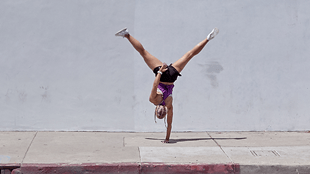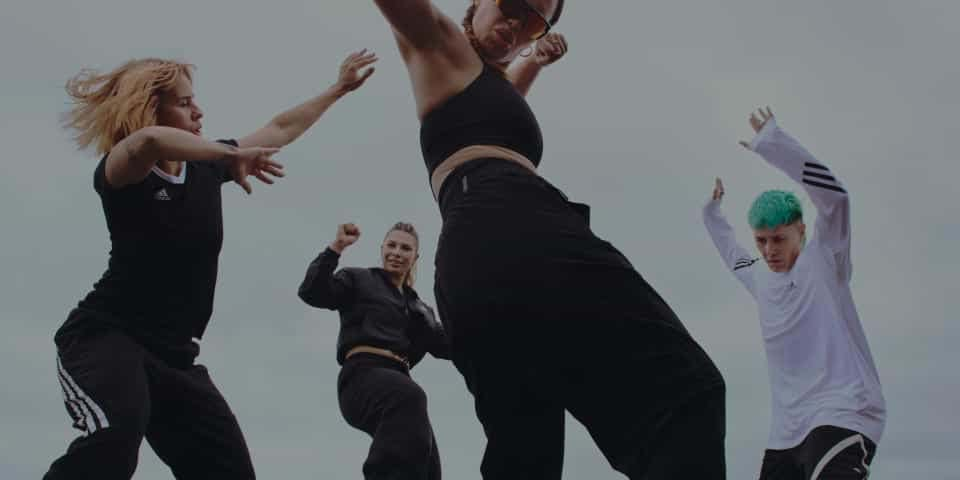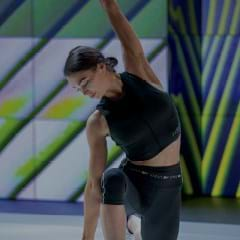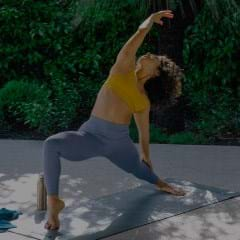“Yes, totally!,” exclaims Bas Hollander, a Les Mills Trainer who spent the first lockdown of 2020 on a mission to master the move. He says it took a lot of time and patience, but it’s paying off. “It’s increased my body control and balance, I have a stronger core and my shoulder strength has developed remarkably.” And there have been aesthetic benefits too. “My wife told me she’s noticed my shoulders are way more muscular, which is an added perk.”
Lisa Osborne, BODYATTACK™ Program Director, has been a master of handstands for years. ”They are a great way to improve upper body strength and shoulder stability, and they are just so much fun!” Handstands also put you on the fast-track to superior core strength, engaging all your abdominals as well as your hip flexors, hamstrings, inner thigh muscles, and lower back. Lisa believes this is the most important benefit. “They build a strong core and strong tension in your whole body, which is what we need for great posture and movement in everyday life.”
“They build a strong core and strong tension in your whole body, which is what we need for great posture and movement in everyday life.” Lisa Osborne
Of course, you don't need to be able to walk on your hands to get through everyday life. So what’s the point? "Sure, we don't need to stand on our hands, but we also don't need to be able to do 50 perfect push-ups or hold a hover for minutes on end," explains Bas. “We do these exercises because they make us stronger, better and more agile when it comes to everything else.”
And for most, building strength is not really what handstands are all about. After all, there are plenty of other exercises that will effectively work the same muscles … shoulder presses, push-ups to name a few. Handstand fans say mastering a handstand offers something much more powerful than increased strength. The real buzz comes from challenging yourself and mastering something new. "It's a skill that shows control over your whole body," adds Bas. “And it’s great for the soul,” says Lisa. “It’s the type of fun challenge that keeps you committed to training and practice!”
Do handstands help your mental health?
Some proponents say handstands create a sense of calmness and promote clarity of mind. While no firm research confirms this, there are claims that yoga inversions (poses where you bring your head below your heart) are the ultimate mood booster. It is thought that increasing blood flow to the brain may reduce the production of the stress hormone cortisol and can relieve short-term depression and anxiety.
To date, one study has focused on the rewards of inversions during yoga. This research found that a regular inversion practice contributed to increased heart rate variability or variations in the pace at which your heart beats. We know from other research that increased heart rate variability can be very beneficial; contributing to improved sleep, more motivation and confidence and reduced feelings of negativity, anxiety and tension.
The calming effects of handstands are something Bas has yet to experience. “Perhaps this comes about when you become a true master. I can imagine it being calming when you can really control the movement without having to think about it. I am not there yet, It is actually quite a challenge to concentrate on holding the movement, there is no time for relaxation!” Lisa also doesn’t see the calming effect – “Handstands just excite me!”
ARE ALL HANDSTANDS THE SAME?
There's a lot of variation and crossover when it comes to handstands. Free holding handstands and handstand walk progressions are gymnastic-based and often adopted in athletic training. In yoga, there are many inversions (poses where the head is closer to the ground than the heart) that progress towards handstands or headstands. These also challenge strength and control but are less athletic.
Should we all start handstanding?
Handstands are not for everyone. If you have wrist, elbow or shoulder issues you should probably steer clear of this upside-down wonder (or at least seek professional advice before you start). Likewise, if you suffer from high blood pressure, eye issues, brain or spinal injuries.
Even if you have no health problems holding you back, experts still recommend you take it slowly. “We’re not used to spending much time on our hands. so do take a few weeks to build up strength in the arms and shoulders,” advises Bas. “And always warm up the wrists, shoulders and core before you start,” adds Lisa. She says it’s important to have an understanding of the right progressions and not try kicking your legs up against a wall without enough arm and upper body strength to hold your body weight – if you do, you risk crumbling to the ground, or kicking a hole in the wall! “And you also must learn how to get out of a handstand safely. You can’t just fall – it’s so important that there is control.”
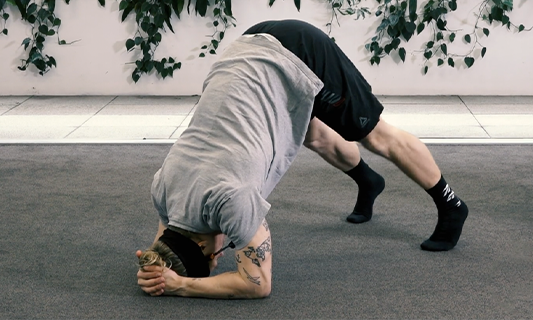
There are many ways to improve your upper body and core strength through the basic progressions of a handstand. Surprisingly, you can even enjoy handstand skills and practice without your feet leaving the ground. “A great handstand actually starts with core work – lying down handstand positions and strengthening exercises,” explains Lisa. “It’s called a dish and an arch and you learn it on the ground first. Then you progress by putting your feet up on a box, or even the bed, and you just gradually put weight on your hands with straight arms.”
Whatever you do, be patient and build the intensity and duration of your handstand training slowly, advises Bas. "Progress takes a long time," he explains. "I have been practicing daily for ten months now. Even now, I can only get into a good position about 90 percent of the time, and half the time I can hold my balance." He says one of the best ways to progress has been filming himself and checking his technique.
It can take months – even years – of training to perfect the handstand and make it look effortless. But with enough dedication, it's a skill that everybody can and will develop. The trick is to keep the practice up and do it every few days, and you’ll only spend that time on it if you enjoy the training itself. This is why Bas developed his very own handstand training series.
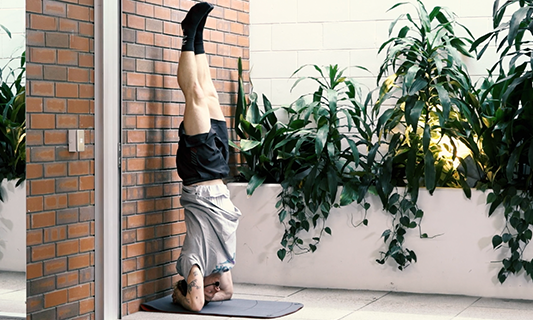
Bas’ handstand series is available exclusively on LES MILLS™ On Demand and features seven 25-minute handstand-inspired strength and skill sessions that help you build strength and learn techniques to progress or develop your handstand. Even if you don’t want to become handstand pro, you’ll still love these workouts – it’s great bodyweight training. Already thousands have tried it and they’re now hooked.
“I had never tried handstands or headstands, my upper body strength is definitely my weakest point, but I LOVED this workout! I found it very easy to follow, and it has so many options!” Sabrina Codino
“This training has helped me immensely. My back pain is totally gone … my alignment is better and my core is much stronger. I don't know if I'll ever be able to get rid of the wall. But my main focus is how it helps me think about my body positioning and control, the health benefits and improvements I am seeing in other workouts.” Eva CostaRubio
"This is my new favorite! I learned more about handstand technique in these 25-minute sessions than in 10 years of club-level gymnastics – and Bas is 1000x nicer than any of my coaches!" Charlotte MacKay



